LA TOLTECA #6 September 18, 2020: Califas Creatives
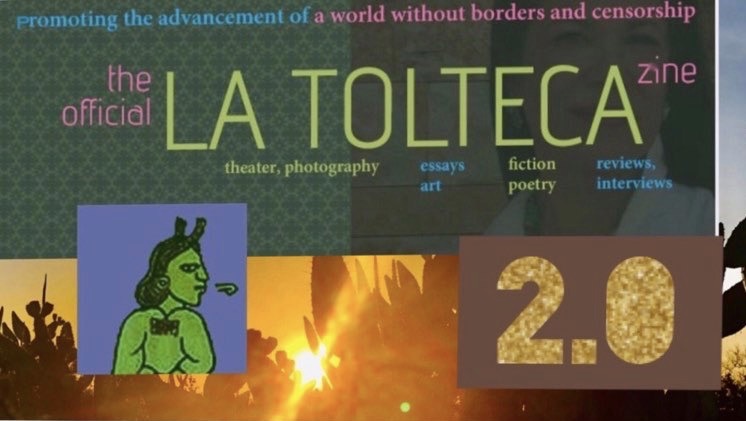
La Tolteca 2.0 September 18, 2020
Latinos comprise 60% COVID-19 cases in California. Latino/as are among the essential workers, they live in inter-generational households, and some do not have health insurance. Many suffer from health disorders that make them more susceptible to contracting the virus. Troubles have recently compounded with devastating fires. Drastic and immediate climate change measures must be undertaken. At the U.S./Mexican border there remains the disgraceful detention of brown children separated from parents who legally sought asylum. While in the U.S. we anticipate the national elections and begin now by early voting and absentee voting, we send our hopes for continued surviving and thriving to all in that wonderful state.

You don’t have to be a Babe-Boomer or Brown to submit a selfie or fave pic of yourself: ana@anacastillo.net.

Sonia Gutiérrez teaches gender studies and critical thinking in higher ed. Recovering from COVID-19 she returns to her poetry featured here.

Paul Rentería, actor in “The Biker Movie” yet unreleased. See his creative non-fiction story in this issue
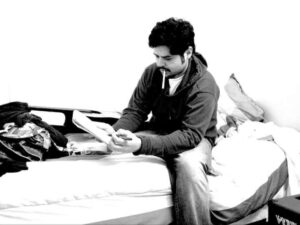
Alex García taken by former bandmate David Seif, 2010 while working on music. See García’s digital art in this issue.
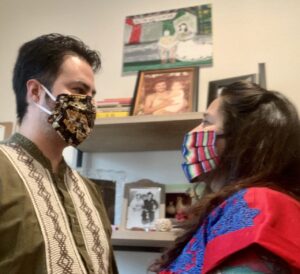
Sarah Rafael Garcia y Manuel G. Galaviz at home in quarantine. Her testimonio on contracting COVID-19 below.
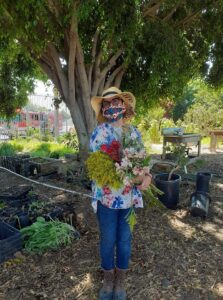
Dulce Stein, Curator at The Neutra Institute Museum and Gallery finding healing from life in quarantine in community gardening. Photo credit: Griselda Rentería.

Michael and Barbara Sedano at home in Pasadena. His nature photography featured here.
Alex García (aka Alex García de Aztlán, aka:

On social media I’ve named myself Alex Garcia de Aztlán as a shout out to Aztlán. Someday I’ll legally add it to my name b/c I was born Chicano, in este lado, in the US, southwest.

Digital artist, Alex García
I was born in the mostly Mexican, working class, half suburb-half industrial city of Sun Valley, California.
The techniques involve extreme brightening of colors or removing colors and adding flashy comic-like backgrounds or no background at all. I work with as many free apps or easy to use image enhancement programs as possible on my laptop. This approach to my art is deliberate.
I work with as many free apps or easy to use image enhancement programs as possible on my laptop. This approach to my art is deliberate.

“el/ar” of my Lotería Indigena Series
At first glance, the viewer might decide that my work appears amateurish (pixilated or not sharp.) I feel that with persistence, I can mix and mash with the same free software everyone is using to filter or enhance their selfies and other social media pictures. I feel that if I can’t create something that anyone else couldn’t make themselves without having to buy an expensive software program, then I don’t want to make that kind of art. In other words if I can do it, so can you.
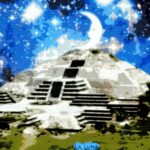
“la/lu” this is 2 of 4 of my “loteria indigena” series.

“Earth’s Hustlers”
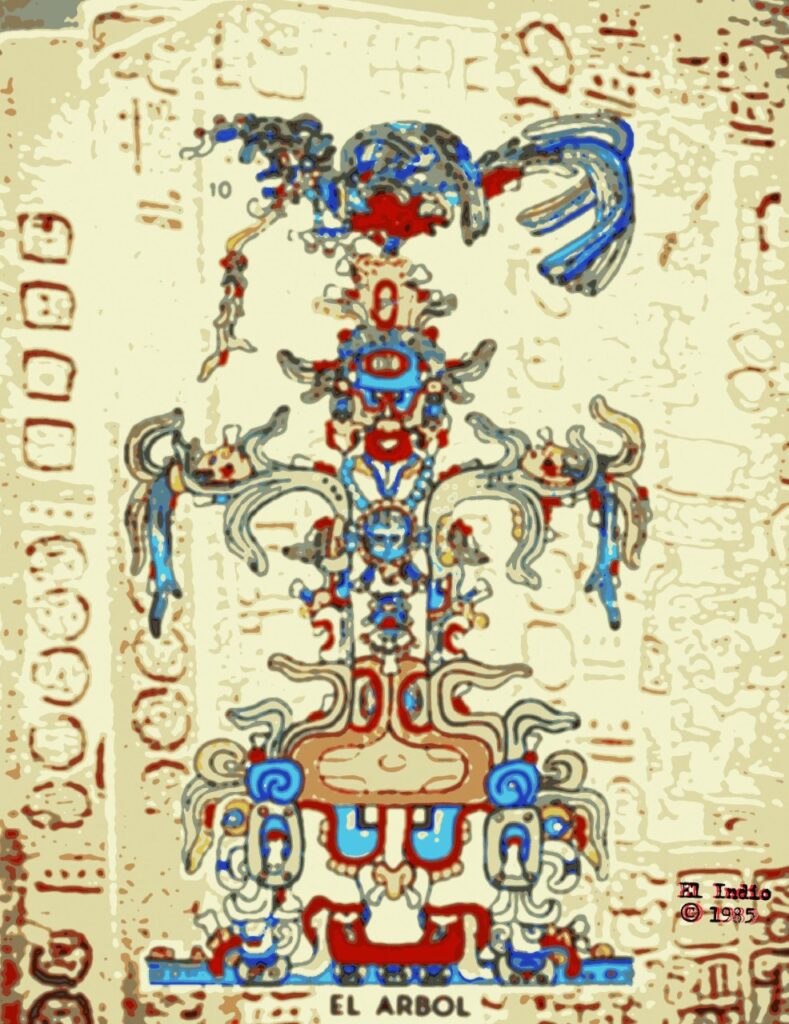
“el/ar” this 3 of 4 of my “loteria indigena” series
THERE ARE NO “DIMENSIONS” UNTIL I PRINT THEM, WHICH IS ALMOST ALWAYS SIZED AT 10×14, BUT THIS VARIES BASED ON CLIENT/BUYERS/EXHIBITION’S PREFERENCE. ~
~ El Indio © 1985
Michael Sedano
says of his life: “retired from a fun, and diverse, career in corporate management to garden, write, and use time as it demands.” This includes photography.
He is Co-founder, with Rudy Ch. Garcia and Manuel Ramos, of La Bloga, and its Tuesday columnist.
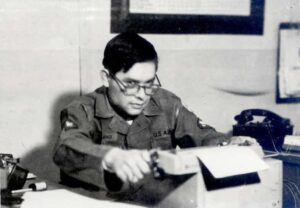
Sedano, Information Specialist and editor of The Hilltopper, newsletter of the 7th of the 5th air defense battalion 38th ADA Brigade.
A Veteran of the United States Army, Michael Sedano served thirteen and a half months in Korea, as “first to fire” air defense artillery. Michael values that fabulous panorama from the world’s highest HAWK site, especially in winter blizzards and heart-quaking thunder storms. Michael is full-time caretaker for his disabled wife. They celebrate fifty-two years married, in August 2020.
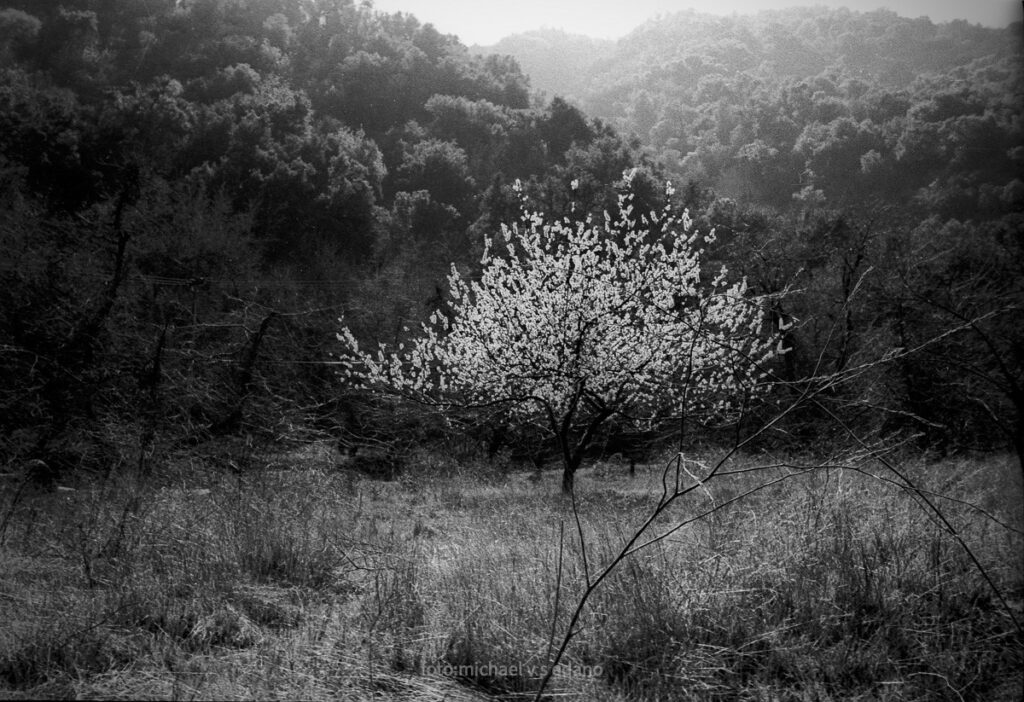
Santa Paula Canyon fruit tree, photo credit: Michael Sedano
Artist Statement:
“The earliest flower I remember is the small, deep red epiphyllum hanging from la mora in my grandmother’s back yard.
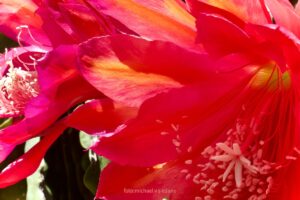
Color de orange, photo credit: Michael Sedano
The plant’s gorgeous red trumpet caught my eye, then my attention took in its hanging pencas, tiny espinas, variegated coloration. “Gramma, es del monte, o de la casa?” Gramma answered and widened her grandson’s worldview,” some things are of both worlds, like you will be.”
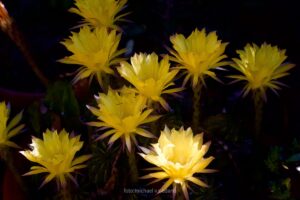
FlyYellow Echinopsis, photo credit: Michael Sedano
“Blossoms are like that memory, a beautiful thing that happens that one time. Epiphyllum flowers happen ephemerally, one day and ya ‘stuvo. Some of the most gorgeous flowers achieve peak beauty only in darkness. Sublime, but not for our eyes. Moths, bats, crawling nectar-seekers drawn in darkness toward ethereal perfume, they arrive under starlight.”
“Bees know different flowers, in sunlight. Just like
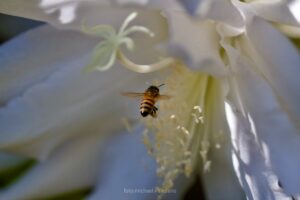
Honey bee White Stigma, photo credit: Michael Sedano
photographing the Night-blooming Cereus in her fulness requires a sleepless night, for sunlight visitors, sit, wait, anticipate. Thank you, Bee, for a lot of things. Click.” ~ Michael Sedano
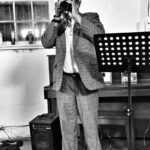
The photographer featured here.
Dulce Stein
(Art Curator)
I started spiraling with depression and anxiety after the Stay at home orders . I have always been very active in the arts community as Chief Curator of The Neutra Museum Gallery and Curator at The Chicano Resource Center. 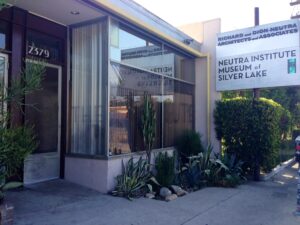
I started looking for a way to cheer myself up and invited muralist and friend to help me with a community mural in Hawthorne. It was a breath of fresh air and much needed healing. 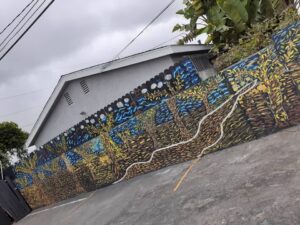
I also started for the first time ever volunteering at Watts healing community garden. What a blessing I found in learning how to grow in a positive way and now we are tending in our own space at The Heart of Watts community garden. Art and gardening gives me time to heal and grow, making me stronger and happier as I need to find peace of mind and compassion as we navigate in these unexpected and chaotic times. It is always an honor to serve my community.
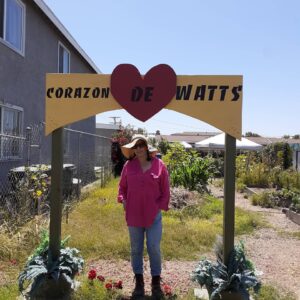
Dulce Stein in Times of Covid-19 Photo credit: Griselda Rentería.
Currently, I’m involved in a project called Arts at Home in partnership with our local channel 22 , the Commissions of Fine Arts in Hawthorne and local business. We are raising funds to funds to create opportunities for artists, gardeners and cooks. Our mission is to offer workshops and at the same time create jobs for our art community.
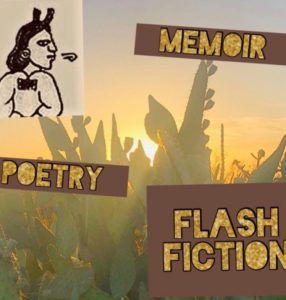
Sarah Rafael García
(Testimonio)
No Symptoms (Asymptomatic).
At thirteen, I learned nothing lasts forever. I know this because my father only lived until thirty-six. I’m forty-six-years old. I’m surviving a pandemic by fearing mask-less people. So far, I’ve lived ten years longer than Papi.
It took me forty-four years to marry a Chicano. We got married in Chicano Park on June twenty-third in 2018. Surrounded by familia y los amigos más chingones. I read my version of the poem Dulzura by Cisneros as my vows; he wiped undocumented Jalisco tears from his cheeks.
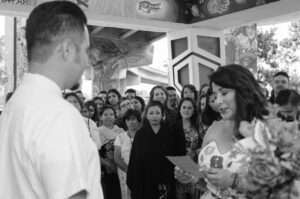
Photo credit: Edith Jiménez
Our reception was held at El Centro Cultural de la Raza. We had mariachis, ballet folclórico and
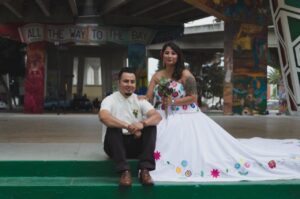
Photo Credit: Edith Jiménez
our song was Suavecito by Malo. We toasted with tequila, craft beer and gluten-free cupcakes. We had the rest of our lives to remember it all. La, ah, ah, ah, La, la, la, ah, ah, ah…
Two Years later when the pandemic hit, along with the rest of the country we were mandated to stay home. His parents kept asking to see us. His mother’s birthday passed, Mother’s Day passed, Father’s Day passed and soon summer would pass too. We did not want to get his parents sick, so we got tested on our second wedding anniversary. My mother-in-law cleans houses for a living, my father-in-law mops tar on roofs. My husband works on his dissertation, I sometimes write books and ship them to gente across the nation. He tested negative.
I tested positive for COVID19.
Asymptomatic. Did you know that means “no symptoms”? I didn’t. I googled the word after speaking to the health department agent. She said I wasn’t the only one. I’d always worn a mask. My husband had, too. Unlike others, I didn’t lose my sense of taste. I never had shortness of breath. Asymptomatic.
The agent also said I wasn’t a priority and advised me over the phone to quarantine for fourteen days. That meant my husband slept on the couch and I couldn’t leave the bedroom. We avoided contact with other people. I made a list of those I could’ve infected. I told my friends. I hoped they could be a support system. Some shared my health status without my permission. Some even said I was “lucky.” Not sure if they meant it because I had no symptoms or because I was still alive. I still feel guilty that I may have caused someone to die.
I am pro-masks. I am pro-testing. (I am also pro-choice.) I had to go through two consultations to donate blood. It was the only way I could get an antibodies test. Since I never experienced any symptoms, I wasn’t able to obtain another COVID19 test without lying. For everyone’s benefit, and so I wouldn’t lose any more friends to this virus, I chose not to lie. I was afraid if I did, I would add to the coldhearted reactions, exhausting anxiety, and thousands of deaths this virus has caused.
I tested negative for antibodies. But that only means I can test positive for COVID19 again. Now, the pending grief dwells more on my mind than the actual symptoms.
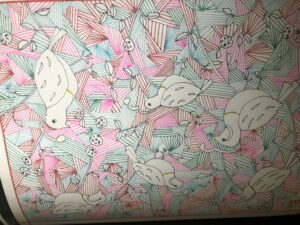
Sonia Gutiérrez
ONE DAY I COULD SEE DEATH
One day just like that
I could see death,
so I did what I could do— I called her spirit back.
Sitting across from her, she sank in the quicksand of her words:
“I’ve been crying for a year and a half.”
One day just like that 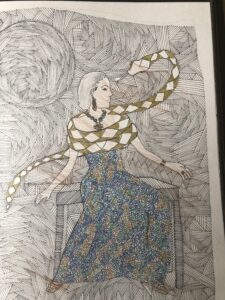
I could see death,
So I threw a fishing rod
across the desk and reeled her in with stories because I too
had once been in that drowning place.
Day in and day out I too had witnessed
the heaviness of purple waves with eternal blueless skies pressing down on my gills.
So I asked, “Do you know why I stopped crying?”
while she held her head above water and silence escaped her gaping mouth.
For several months,
I fell asleep crying
One day when I woke up,
where there had been two obsidian eyes with heightened sight
were two-ball black head pins.
Where there had been two plump
cheeks were now two sunken salty creeks. Where there had been a mouth,
a selfless drought had sealed my lips shut.
Until the day of the calling,
from my Mexican bathroom mirror,
María Felix and my mother reached out, so I could reclaim my beauty,
and remember what it was like to be me— a soldadera armed with a lasso tongue, graced with thorny cactus skin
and self-healing entrails.
From the treacherous current,
I pulled her in with stories
as I removed seaweed,
and the salty pearls from her eyes. I locked her arm with mine
as we giggled and walked back to shore, as the salt of her eyes receded.
Moraleja para una mujer: Salt water belongs in the ocean not on a woman’s lunaface.

Sonia Gutiérrez, self-portrait.
Testimonio:
I received my results seven days later. When I broke down over the phone, the health official told me, “Señora, don’t worry. It sounds like you are coming out of Covid.” My beloved got tested the next day and his results came back positive. Our first born, age twelve, mentioned a headache, so we took her in for a test. Negative. Since Paulino at times coughed more than me, I asked him to ask his doctor for an inhaler. It worked. During this time, we wondered if our condition had improved or worsened.
I also remembered when my mother boiled eucalyptus leaves to heal my brother, by having him inhale eucalyptus steam, so I did the same for my beloved. I would cover Paulino’s head with a towel and he inhaled my mother’s green medicine several times a day. We, of course, took painkillers and drank lots of liquids.
It’s now September. It’s been two months since we had Covid. Sometimes, I wonder if my sense of taste has been compromised. My beloved’s lungs are dealing with the secuelas del Covid. I discovered being 0+ did not mean Covid-19 was going to spare me from experiencing frightening Covid symptoms. For now, I stay away from the people I love, my brothers and sister; we text each other. I’ve learned that it is difficult for people who come from communal societies to stay away from each other and that Mexicans are afraid of hospitals.~ Sonia Gutiérrez
Sonia Gutiérrez is the author of Spider Woman / La Mujer Araña (Olmeca Press, 2013) and the co-editor of The Writer’s Response (Cengage Learning, 2016). Dreaming with Mariposas (Autumn, 2020 with FlowerSong Press; McAllen, TX.). “One Day I Could See Death” is from the unpublished poetry collection, SanaSana Colita de Rana.
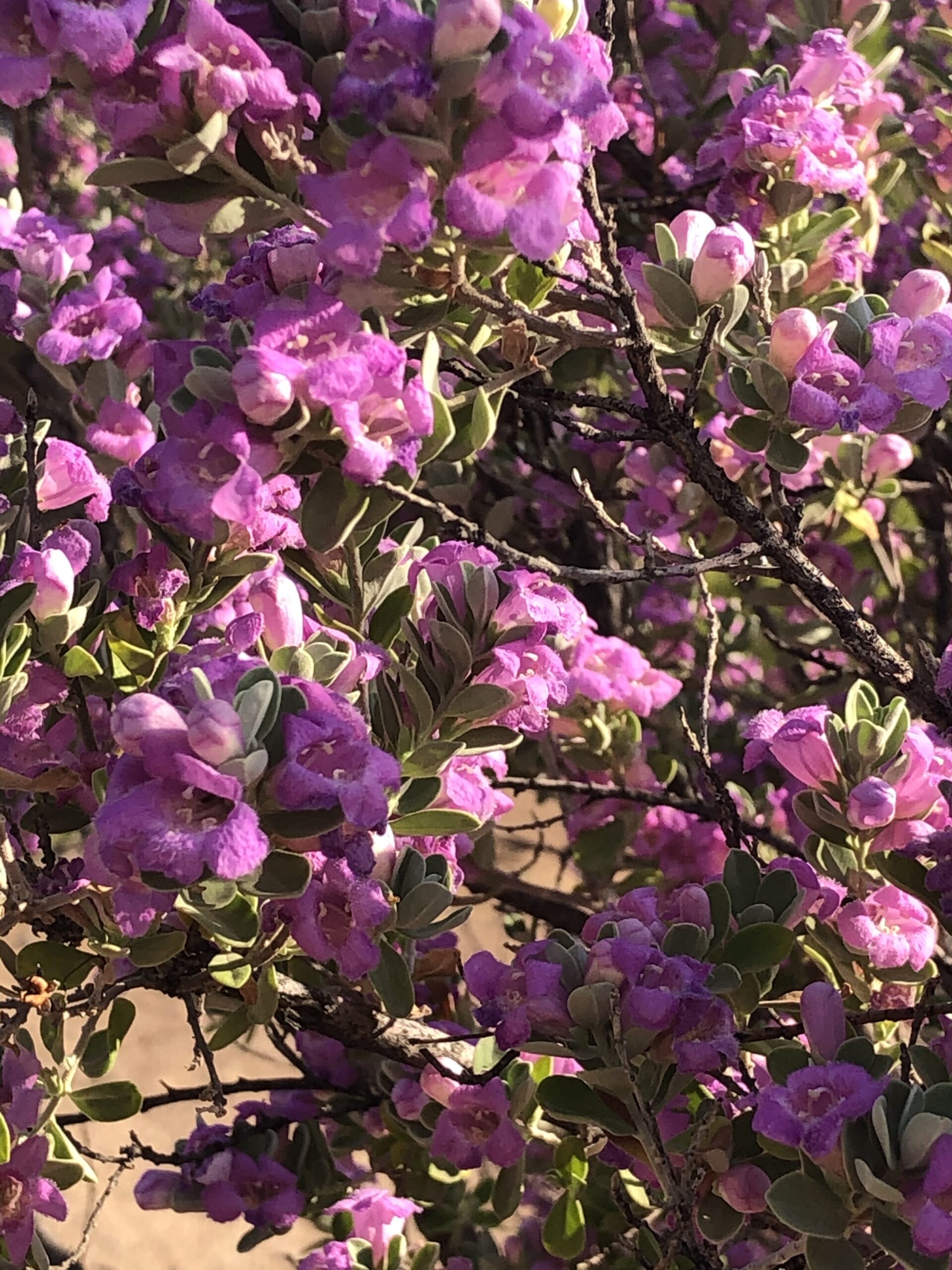
Paul Rentería
Pinto the Ranch Dog (creative non-fiction)
Pinto the Ranch Dog was a very different type of dog, the likes of I had never
seen before. He was one half Australian sheep dog and one half Queensland
sheep dog. From what I’ve been told, the Queensland was derived from the
native Dingo a wild and very hearty dog in Australia.
One day while I was driving my truck from my ranch to the store, my dog Bear,
a very smart Labrador and Pit Bull mix, spotted about four hundred sheep
grazing in a canyon near our ranch. He jumped out of the truck and chased the
herd of sheep into several groups running in all directions. I got nervous, excited
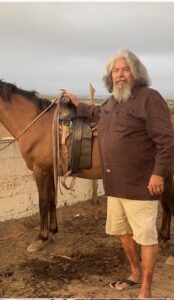
Paul Rentería
and scared that he would injure or possibly attack the sheep. I was able to jump
out of my truck and call him back. I don’t think he ever had any intention of
hurting them , but just wanted to play! He came back wagging his tail and
jumped back into the truck. We continued our journey to the store with no
further incidents.
That night, there was a knocking on the front door, and it was the sheep
herder of whose sheep were spread throughout the canyon a few miles from
our ranch by Bear earlier that day. He looked like a Western Cowboy but was a
Spanish Basque sheepherder and spoke Spanish. He wore a cowboy hat,
cowboy boots, Levi’s and was carrying a six-shooter gun strapped to his side. I
immediately thought he was going to ask me to reimburse him for lost or injured
sheep. Instead, he asked me if he could graze on our ranch for three to four
days and wanted to water down his sheep! I gladly allowed him to graze and
he agreed to get his trailer and move the sheep in the next morning. When I
awoke the next morning, there were four hundred sheep eating up all of the
ground cover, including any grasses, flowers and weeds. It was a beautiful
scene like right out of a western movie! I was happy to see so much weed
removal done by the chomping sheep. I had a few tinas, large steel water tubs
that usually held cold beverages at ranch parties. The thirsty sheep were lining
up and sucking up the water, with loud slurping sounds as they hadn’t had a
drop of water in a few days! I was alerted by the growls and barks of a nursing
Queensland female dog who was guarding her pups underneath the
sheepherder’s trailer. It was a fascinating site to see, as she would take breaks
and run out to circle the herd of sheep, then would return to nursing her pups.
My two dogs learned to stay away from her and to respect the sheep. They
learned to ignore the sheep and just followed me as I rode my horse Smiley
around the herd.
After four days, the sheepherder told me that they were going to be leaving
and he offered to pay me for grazing on my ranch. I would not take his money
as I told him the sheep did a great service of cutting down on weeds! What he
did next surprised the heck out of me! He offered to give me one of his pups! I
told him I could not accept such a nice gift and that he should sell it. He told me
he wanted me to have it and that it was time to wean the pups and that his
female needed a break and to save energy, by not having to nurse one less
pup! I then gladly accepted this gift and was honored to be thought of so highly
by the sheepherder.
“Pinto” was like an appaloosa horse with his colors. His silver and black
reminded me of my favorite football team The Raiders! Pinto did not like to lay
around with the others, as he would not get close to anyone and would stand
off at a distance observing everything, no doubt a part of his herding instincts.
After my girlfriend Margie moved to the ranch, Pinto would only go to her. The
day after Margie committed suicide, Pinto disappeared.
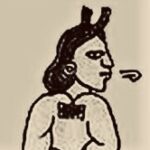
GUIDELINES:
Except for La Tolteca 2.0 images all contributing images of art and photos are previously unpublished and credited.
LA TOLTECA 2.0 had made its return here at www.anacastillo.net It is a virtual zine with ongoing posts.
You may submit to ana@anacastillo.net
You’ll receive an automated response. (If you don’t receive the automated response alert me on FB messenger) For consideration to the following new features only unpublished, never posted on SM, original images and material.
New L/T 2.0 Features
BOX 4B: Brown & Beautiful Babe-Boomers
You don’t have to be brown or a Boomer and your submissions don’t have to be selfies to submit. Send us what gave you a smile, lifted your spirits, kept you going that past week. Smart phone pics work, no specific format necessary. Do NOT send images previously posted on social media or elsewhere. Your submission is consent for use at L/T 2.0. Add a couple of lines with your name and about the pic or yourself to be included, if selected. If any of your submission is selected it will be posted the following Friday. If not, you won’t hear from us but you will be welcome to send something new for consideration again.
Yo ¡Presente!
No rants or editorials, please. Only clean, proof-read submissions in a journalistic style will be read for consideration. Double space, 12 point, Times Roman—750 words. Your most recent activist concern. Include your name and a line describing how you participate in social justice issues. Checklist for your piece: What, when, why who and how.
Poetry. Flash Fiction, Memoir and Testimonio
Original and unpublished work. Spanish and English languages considered.
All submissions must have been proofread double-spaced, 12 point, paginated. Fiction word count limit 750. Your name and one line about yourself or your submission.
La Tolteca 2.0 is a blog. We reserve all rights to post as and what we choose.
If your original works appear here you may use again elsewhere with credit to first appearing at La Tolteca 2.0 (and date.)
Thank you for reading, feel free to share link and all positive vibe comments welcome. Issue #7 with more fabulous creatives, thrivers and survivors on Friday, October 2, 2020. You don’t have to be brown and a babe boomer to submit but if you are, we are here for you. We are present and forging on through next elections.

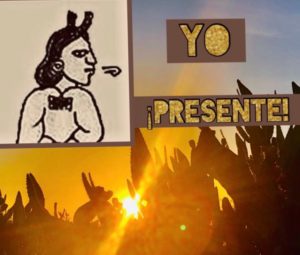
3 Comments
Alex September 19, 2020 - 16:45
Thanks again for featuring my work. And thanks for creating a space for creatives to share their work! This was a lot of fun.
Ana Castillo September 20, 2020 - 15:20 – In reply to: Alex
Thanks for your contribution in L/T 2.0 #6. Pass on the link!
Alex September 21, 2020 - 04:28
Thank you!
Shared!